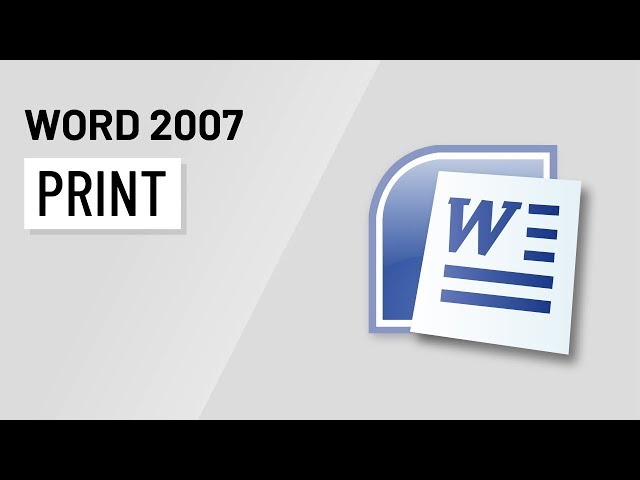
Introduction:
Printing remains a fundamental aspect of document creation, and Microsoft Word 2007 introduced a range of features to streamline and enhance the printing process. In this comprehensive guide, we will delve into the intricacies of printing in Microsoft Word 2007, covering everything from basic printing options to advanced settings that empower users to produce high-quality, professional documents with precision and efficiency.
I. Understanding the Basics of Printing:
- Purpose of Printing:
- Printing serves as a tangible and shareable representation of digital documents, allowing users to create hard copies for various purposes, including presentations, records, and archival.
- Printing Workflow:
- The printing workflow involves selecting a printer, specifying print settings, and managing the print queue to transform digital content into physical documents.
II. Selecting a Printer:
- Printer Options:
- Word 2007 seamlessly integrates with a variety of printers, from local printers to networked or wireless devices. Users can select the desired printer based on their needs.
- Printer Settings:
- Access printer settings to configure preferences such as paper size, orientation, and print quality before initiating the print job.
III. Print Preview:
- Visualizing the Output:
- Print Preview in Word 2007 allows users to visualize how the document will appear on paper, ensuring that formatting, layout, and content meet their expectations.
- Navigating Print Preview:
- Navigate through multiple pages in Print Preview to review each aspect of the document before committing to the print job.
IV. Setting Page Layout:
- Page Size and Orientation:
- Adjust page size and orientation to match the intended output, ensuring that the document fits well on the selected paper.
- Margins and Alignment:
- Fine-tune margins and alignment settings to optimize the appearance of the printed document and maintain a professional look.
V. Choosing Print Options:
- Number of Copies:
- Specify the number of copies to be printed, catering to different distribution needs, such as multiple recipients or document sharing.
- Collation:
- Enable collation to organize printed copies sequentially, streamlining the process of assembling multi-page documents.
VI. Print Range Options:
- Print All or Selection:
- Choose between printing the entire document or a specific selection, providing flexibility in managing print jobs for lengthy documents.
- Page Range Selection:
- Specify a custom page range for printing, allowing users to focus on specific sections or pages of the document.
VII. Advanced Print Settings:
- Color or Black and White:
- Select color or black-and-white printing based on document requirements and budget considerations.
- Print Quality:
- Adjust print quality settings to optimize for either draft or high-resolution printing, balancing output quality with ink or toner usage.
- Duplex Printing:
- Enable duplex printing for double-sided output, reducing paper usage and creating more environmentally friendly documents.
VIII. Watermarks and Background Printing:
- Watermark Addition:
- Enhance document aesthetics by adding watermarks, logos, or background images that become part of the printed output.
- Background Printing:
- Enable background printing to allow users to continue working in Word while the document is being printed in the background.
IX. Handling Page Breaks and Section Breaks:
- Controlling Page Breaks:
- Use page break and section break tools to control the layout and appearance of pages, ensuring proper pagination in the printed document.
- Section Break Types:
- Familiarize yourself with different types of section breaks, such as next page, continuous, or even odd/even, to tailor page breaks to specific document needs.
X. Printing Envelopes and Labels:
- Envelope Printing:
- Word 2007 provides tools for printing envelopes, allowing users to create professional-looking envelopes for mailing purposes.
- Label Printing:
- Generate labels with ease by leveraging Word 2007’s label printing features, saving time and ensuring consistency in addressing.
XI. Print Macros and Automation:
- Recording Print Macros:
- Advanced users can explore the option of recording macros to automate repetitive print tasks, enhancing efficiency in large-scale printing projects.
- Customizing Automation:
- Customize macros to suit specific printing needs, automating intricate processes and reducing the risk of manual errors.
XII. Print Management and Troubleshooting:
- Managing Print Queue:
- Monitor and manage the print queue to check the status of print jobs, cancel unwanted print requests, and troubleshoot any printing issues.
- Troubleshooting Common Issues:
- Familiarize yourself with common printing issues, such as paper jams, printer connectivity problems, or driver issues, and learn how to troubleshoot them effectively.
XIII. Print Security Considerations:
- Secure Printing:
- Implement secure printing practices, especially when dealing with sensitive or confidential documents, to protect information from unauthorized access.
- Document Encryption:
- Explore document encryption options to add an extra layer of security to printed documents, safeguarding them from potential breaches.
XIV. Print Preferences and User Profiles:
- Customizing Print Preferences:
- Save time by customizing print preferences and creating user profiles for frequent printing tasks, ensuring consistency across multiple print jobs.
- Switching User Profiles:
- Switch between user profiles based on specific printing requirements, streamlining the process and minimizing the need for manual adjustments.
XV. Mastering the Art of Printing:
- Continuous Learning:
- Mastery of printing in Microsoft Word 2007 involves continuous learning and exploration of advanced printing features and techniques.
- Utilizing Online Resources:
- Explore online tutorials, forums, and Microsoft’s official documentation to stay updated on the latest printing features and best practices.
XVI. Conclusion:
- Achieving Print Excellence:
- By mastering the art of printing in Microsoft Word 2007, users can achieve print excellence, producing professional, polished documents with precision and efficiency.
- Efficiency and Document Integrity:
- The effective utilization of Word 2007’s printing features not only enhances workflow efficiency but also contributes to maintaining the integrity and professionalism of printed documents.
As you navigate the rich landscape of printing in Microsoft Word 2007, you embark on a journey of transforming digital content into tangible, high-quality documents. Embrace the diverse features, optimize print settings, and leverage advanced options to ensure that your printed output meets the highest standards of clarity, professionalism, and efficiency.